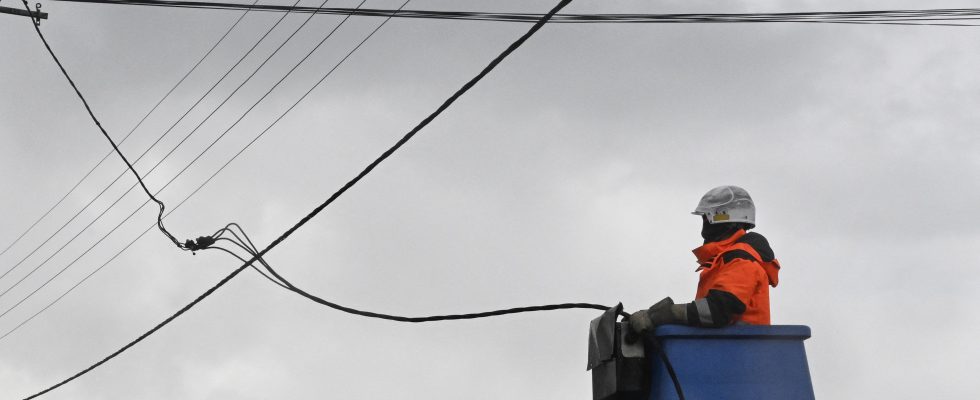The ballet of blue trucks began a few hours before the storm. Technicians from Enedis, the electricity distribution network manager, rushed to reinforce the west and north of the country, pre-mobilized before Ciarán’s arrival on the French coast. Forecasters had been anticipating a major storm for several days: it actually happened, killing two people according to a latest report.
Exceptional wind gusts were recorded in Brittany, with records broken in Plougonvelin (193 km/h), Lanvéoc (171 km/h), Brest (156 km/h) and Lorient (148 km/h). In the early morning of Thursday, November 2, 1.2 million homes were without electricity due to trees falling on the lines, pylons or cables being torn – a majority of them in Brittany (780,000) and in Normandy (255,000). This is “up to three times higher than what was considered to be the storm of the century, in 1999”, declared the president of Enedis, Marianne Laigneau. In some places, “the network has been cut short,” she insisted.
In an emergency, Enedis thus activated its rapid intervention force – FIRE, created after 1999 – made up of “3,000 employees and service providers mobilized with appropriate logistical resources, 300 generators and 30 helicopters, ready to intervene as soon as conditions permit. will allow, to restore electricity as quickly as possible to the impacted areas. And to repair the “13 high and very high voltage lines which stopped” last night, the electricity transmission network manager (RTE) told L’Express, which is equivalent to the electrical needs of 11,000 homes.
“Anti-waterfall pylons”
The material damage, however, seems incomparable to that of the Lothar and Martin storms at the end of the last century, when more than 1,000 pylons were affected and 184 electrical stations were taken out of service. France has since learned many lessons from these episodes. RTE has in fact consolidated its network, notably with the creation of “anti-cascade pylons”. Installed every 10 supports, they are reinforced to resist a complete break of the cables, whether this happens on one side or the other of the support, and thus avoid a costly game of dominoes on the line. “Adaptation strategies are implemented by managers in response to most current climatic hazards, but also taking into account the future climate,” indicate the authors of a analysis note from France Stratégie dating from March 2022. They have proven profitable, they confirm, for example “during winter storms by limiting the widespread ruins of pylons”.
Although Enedis, like RTE, have undertaken lengthy works to limit major outages, it remains impossible to secure all of the installations. After each storm, technicians and service providers must travel along departmental roads to repair damaged portions of the electricity network, on which transport and telecommunications also depend. “Half of RTE’s 9,500 employees are dedicated to maintenance, they work every day to prune and check that the lines are not too close to vegetation,” the group also underlines.
Even if almost all of the new lines are underground, the French network remains largely in the open air. And therefore particularly exposed during storms. According to RTE data in 2022, France has nearly 100,000 kilometers of overhead lines, compared to just over 7,000 kilometers of buried lines. This fragility of the network has often been pointed out during episodes of violent winds but the trend, despite recent investments, is not towards total burying of the network: the operation is not feasible in all areas. And above all expensive. “For cost reasons, this is not the solution that was chosen and maintenance is much easier by air,” explains RTE. A strategy which is reflected in the investments of the network manager made after the storm of 1999. The program launched at the time, and endowed with 1.6 billion euros over 15 years, made it possible to identify the strategic lines to ensure a minimum supply, but also to mechanically consolidate the structures so that they can withstand wind gusts of up to 180 km/h.
What effect will future storms have on the network? To try to optimize their response, French electricity players are now banking on anticipation. At Enedis, various projects intended to better understand the impact of storms on its infrastructure are underway. The Windy Smart Grid software, used since 2020, calculates for example “decision-making indicators such as the forecast number of outages caused by a storm”, relates a study published in August 2022. Used successfully to anticipate the impact of storm “Aurore” in October 2021, it made it possible, according to the authors of the study, to pre-mobilize repair teams two days before the gale. In the future, blue trucks should therefore be one step ahead of the weather.
.
